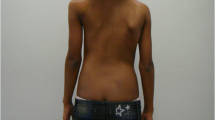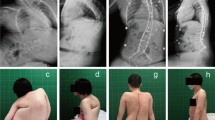Abstract
Purpose
To determine the prevalence of intraspinal alterations in scoliosis due to Spinal Muscular Atrophy (SMA).
Methods
Cross-sectional, observational, descriptive study. Fifty-six patients with SMA diagnosis required surgical treatment due to scoliosis. Inclusion criteria: scoliosis/kyphoscoliosis > 50 degrees in the coronal plane, clinical characteristics of Spinal Muscular Atrophy, accurate diagnosis by means of molecular or genetic study. Prior to the spinal surgery, and to find related intraspinal alterations, MRI of the spine and posterior cranial fossa was performed.
Results
Forty females, 16 males, mean age 11 years (range 6–14 years). 94% of the patients had Spinal Muscular Atrophy type 2. The mean angle value was 81 degrees (range 53–122 degrees) in the coronal plane and 62 degrees (range 35–80 degrees) in the sagittal plane. The prevalence of intraspinal alterations was 1.78%. One patient with cervical hydromyelia and no neurological surgical procedure prior to the spinal deformity surgery was reported.
Conclusions
In the context of preoperative planning and strategy of patients with scoliosis due to Spinal Muscular Atrophy, MRI may have not to be requested.

Similar content being viewed by others
References
Kolb S, Kissel J (2015) Spinal muscular atrophy. Neurol Clin 33(4):831–846
Zerres K, Schöneborn S, Forrest E et al (1997) A collaborative study on the natural history of childhood and juvenile onset proximal spinal muscular atrophy (type II and III SMA): 569 patients. J Neurol Sci 147:67–72
Rodillo E, Marini M, Heckmatt J et al (1989) Scoliosis in spinal muscular atrophy: review of 63 cases. J Child Neurol 4(2):118–123
Russman B, Melchreit R, Drennan J (1983) Spinal muscular atrophy: the natural course of disease. Muscle Nerve 6(3):179–181
Allam A, Schwabe A (2013) Neuromuscular scoliosis. PMR 5(11):957–963
Berven S, Bradford D (2002) Neuromuscular scoliosis: causes of deformity and principles for evaluation and management. Semin Neurol 22(2):167–168
Dewan V, Gardner A, Forster S et al (2018) Is the routine use of magnetic resonance imaging indicated in patients with scoliosis? J Spine Surg 4(3):575–582
Rajasekaran S, Kamath V, Kiran R et al (2010) Intraspinal anomalies in scoliosis: an MRI analysis of 177 consecutive scoliosis patients. Indian J Orthop 44(1):57–63
Lee C, Hwang C, Kim N et al (2017) Preoperative magnetic resonance imaging evaluation in patients with adolescent idiopathic scoliosis. Asian Spine J 11(1):37–43
Swarup I, Silberman J, Blanco J et al (2019) Incidence of intraspinal and extraspinal mri abnormalities in patients with adolescent idiopathic scoliosis. Spine Deform 7(1):47–52
Maenza R (2003) Juvenile and adolescent idiopathic scoliosis: magnetic resonance imaging evaluation and clinical indications. J Pediatr Orthop B 12(5):295–302
Pradha S, Gupta R (1997) Magnetic resonance imaging in juvenile segmental spinal muscular atrophy. J Neurol Sci 146(2):133–138
Smith G, Bell S, Sladky J et al (2019) Lumbosacral ventral spinal nerve root atrophy identified on MRI in a case of spinal muscular atrophy type II. Clin Imaging 53:134–137
Roser F, Ebner F, Sixt C et al (2010) Defining the line between hydromyelia and syringomyelia. A differentiation is possible based on electrophysiological and magnetic resonance imaging studies. Acta Neurochir 152(2):213–219
Jinkins J, Sener R (1999) Idiopathic localized hydromyelia: dilatation of the central canal of the spinal cord of probable congenital origin. J Comput Assist Tomogr 23(3):351–353
Funding
Not applicable.
Author information
Authors and Affiliations
Corresponding author
Ethics declarations
Conflict of interest
The authors declare that they have not competing interest. No conflict of interest or funding received during the conduct of this study.
Ethical approval and informed consent
The study was approved by the hospital Institutional Review Board (IRB), because of the retrospective observational nature of the study IRB waived the informed consent.
Additional information
Publisher's Note
Springer Nature remains neutral with regard to jurisdictional claims in published maps and institutional affiliations.
Rights and permissions
About this article
Cite this article
Davies, N.R., Galaretto, E., Piantoni, L. et al. Scoliosis in spinal muscular atrophy: is the preoperative magnetic resonance imaging necessary?. Spine Deform 8, 1089–1091 (2020). https://doi.org/10.1007/s43390-020-00134-0
Received:
Accepted:
Published:
Issue Date:
DOI: https://doi.org/10.1007/s43390-020-00134-0




